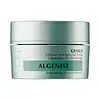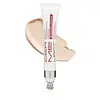What's inside
What's inside
 Key Ingredients
Key Ingredients

 Benefits
Benefits

 Concerns
Concerns

 Ingredients Side-by-side
Ingredients Side-by-side

Water
Skin ConditioningCaprylic/Capric Triglyceride
MaskingGlycerin
HumectantButyrospermum Parkii Butter
Skin ConditioningHydrogenated Polyisobutene
EmollientChlorella Protothecoides Oil
EmollientDimethicone
EmollientGlyceryl Stearate
EmollientPEG-100 Stearate
Cetearyl Alcohol
EmollientCetyl Alcohol
EmollientPentylene Glycol
Skin ConditioningSilica
AbrasiveAlgae Exopolysaccharides
HumectantCollagen
MoisturisingAlgae Extract
EmollientPalmitoyl Oligopeptide
CleansingPalmitoyl Tetrapeptide-7
Skin ConditioningCopper Lysinate/Prolinate
Skin ConditioningMethylglucoside Phosphate
Skin ConditioningAlbizia Julibrissin Bark Extract
MaskingKigelia Africana Fruit Extract
Skin ConditioningPlantago Lanceolata Leaf Extract
AntimicrobialChrysin
Skin ConditioningDarutoside
Skin ConditioningSodium PCA
HumectantLeuconostoc/Radish Root Ferment Filtrate
AntimicrobialStearic Acid
CleansingCeteareth-20
CleansingCaprylyl Glycol
EmollientSteareth-20
CleansingAcrylates/C10-30 Alkyl Acrylate Crosspolymer
Emulsion StabilisingButylene Glycol
HumectantSodium Benzoate
MaskingPotassium Sorbate
PreservativeXanthan Gum
EmulsifyingChlorhexidine Digluconate
AntimicrobialN-Hydroxysuccinimide
Skin ConditioningChlorphenesin
AntimicrobialSodium Citrate
BufferingDisodium EDTA
Citric Acid
BufferingSodium Hydroxide
BufferingPhenoxyethanol
PreservativeWater, Caprylic/Capric Triglyceride, Glycerin, Butyrospermum Parkii Butter, Hydrogenated Polyisobutene, Chlorella Protothecoides Oil, Dimethicone, Glyceryl Stearate, PEG-100 Stearate, Cetearyl Alcohol, Cetyl Alcohol, Pentylene Glycol, Silica, Algae Exopolysaccharides, Collagen, Algae Extract, Palmitoyl Oligopeptide, Palmitoyl Tetrapeptide-7, Copper Lysinate/Prolinate, Methylglucoside Phosphate, Albizia Julibrissin Bark Extract, Kigelia Africana Fruit Extract, Plantago Lanceolata Leaf Extract, Chrysin, Darutoside, Sodium PCA, Leuconostoc/Radish Root Ferment Filtrate, Stearic Acid, Ceteareth-20, Caprylyl Glycol, Steareth-20, Acrylates/C10-30 Alkyl Acrylate Crosspolymer, Butylene Glycol, Sodium Benzoate, Potassium Sorbate, Xanthan Gum, Chlorhexidine Digluconate, N-Hydroxysuccinimide, Chlorphenesin, Sodium Citrate, Disodium EDTA, Citric Acid, Sodium Hydroxide, Phenoxyethanol
Water
Skin ConditioningC12-15 Alkyl Benzoate
AntimicrobialHydrogenated Polyisobutene
EmollientGlycerin
HumectantAcrylates Copolymer
Pvp
Emulsion StabilisingSilica
AbrasiveCetyl Alcohol
EmollientGlyceryl Stearate
EmollientPEG-100 Stearate
PEG-40 Stearate
EmulsifyingDimethicone
EmollientHydrolyzed Sesame Protein Pg-Propyl Methylsilanediol
Skin ConditioningHydrolyzed Wheat Protein
Skin ConditioningSoy Protein Phthalate
EmollientPolyacrylamide
C13-14 Isoparaffin
EmollientLaureth-7
EmulsifyingSteareth-20
CleansingN-Hydroxysuccinimide
Skin ConditioningChrysin
Skin ConditioningPalmitoyl Tripeptide-1
Skin ConditioningPalmitoyl Tetrapeptide-7
Skin ConditioningButylene Glycol
HumectantAcetyl Tetrapeptide-5
HumectantPhenoxyethanol
PreservativeEthylhexylglycerin
Skin ConditioningCI 77891
Cosmetic ColorantCI 77491
Cosmetic ColorantWater, C12-15 Alkyl Benzoate, Hydrogenated Polyisobutene, Glycerin, Acrylates Copolymer, Pvp, Silica, Cetyl Alcohol, Glyceryl Stearate, PEG-100 Stearate, PEG-40 Stearate, Dimethicone, Hydrolyzed Sesame Protein Pg-Propyl Methylsilanediol, Hydrolyzed Wheat Protein, Soy Protein Phthalate, Polyacrylamide, C13-14 Isoparaffin, Laureth-7, Steareth-20, N-Hydroxysuccinimide, Chrysin, Palmitoyl Tripeptide-1, Palmitoyl Tetrapeptide-7, Butylene Glycol, Acetyl Tetrapeptide-5, Phenoxyethanol, Ethylhexylglycerin, CI 77891, CI 77491
Ingredients Explained
These ingredients are found in both products.
Ingredients higher up in an ingredient list are typically present in a larger amount.
Butylene Glycol (or BG) is used within cosmetic products for a few different reasons:
Overall, Butylene Glycol is a safe and well-rounded ingredient that works well with other ingredients.
Though this ingredient works well with most skin types, some people with sensitive skin may experience a reaction such as allergic rashes, closed comedones, or itchiness.
Learn more about Butylene GlycolCetyl Alcohol is a fatty alcohol. Fatty Alcohols are most often used as an emollient or to thicken a product.
Its main roles are:
Though it has "alcohol" in the name, it is not related to denatured alcohol or ethyl alcohol.
The FDA allows products labeled "alcohol-free" to have fatty alcohols.
Learn more about Cetyl AlcoholWe don't have a description for Chrysin yet.
Dimethicone is a type of synthetic silicone created from natural materials such as quartz.
What it does:
Dimethicone comes in different viscosities:
Depending on the viscosity, dimethicone has different properties.
Ingredients lists don't always show which type is used, so we recommend reaching out to the brand if you have questions about the viscosity.
This ingredient is unlikely to cause irritation because it does not get absorbed into skin. However, people with silicone allergies should be careful about using this ingredient.
Note: Dimethicone may contribute to pilling. This is because it is not oil or water soluble, so pilling may occur when layered with products. When mixed with heavy oils in a formula, the outcome is also quite greasy.
Learn more about DimethiconeGlycerin is already naturally found in your skin. It helps moisturize and protect your skin.
A study from 2016 found glycerin to be more effective as a humectant than AHAs and hyaluronic acid.
As a humectant, it helps the skin stay hydrated by pulling moisture to your skin. The low molecular weight of glycerin allows it to pull moisture into the deeper layers of your skin.
Hydrated skin improves your skin barrier; Your skin barrier helps protect against irritants and bacteria.
Glycerin has also been found to have antimicrobial and antiviral properties. Due to these properties, glycerin is often used in wound and burn treatments.
In cosmetics, glycerin is usually derived from plants such as soybean or palm. However, it can also be sourced from animals, such as tallow or animal fat.
This ingredient is organic, colorless, odorless, and non-toxic.
Glycerin is the name for this ingredient in American English. British English uses Glycerol/Glycerine.
Learn more about GlycerinGlyceryl Stearate is a mix of glycerin and stearic acid.
It is used to stabilize the mixing of water and oil ingredients. By preventing these ingredients from separating, it can help elongate shelf life. It can also help thicken the product's texture.
As an emollient, it helps soften skin and supports barrier-replenishing ingredients.
In cosmetics, Glyceryl Stearate is often made from vegetable oils or synthetically produced.
This ingredient may not be fungal-acne safe
Fun fact: The human body also creates Glyceryl Stearate naturally.
Learn more about Glyceryl StearateHydrogenated Polyisobutene is a synthetic polymer. Polymers are compounds with high molecular weight. Hydrogenated Polyisobutene is an emollient and texture enhancer.
In one study, Hydrogenated Polyisobutene showed better skin hydration levels than Caprylic/Capric Triglyceride. As an emollient, it helps keep your skin soft and hydrated by trapping moisture in.
Hydrogenated Polyisobutene is often used as a mineral oil replacement.
Learn more about Hydrogenated PolyisobuteneWe don't have a description for N-Hydroxysuccinimide yet.
Palmitoyl Tetrapeptide-7 (formerly Palmitoyl Tetrapeptide-3) is a lab-made peptide with anti-inflammatory and skin-repairing benefits. It's made up of four amino acids (glycine, glutamine, proline, and arginine) and palmitic acid (which helps it penetrate skin more effectively).
This ingredient helps reduce inflammation by limiting the production of interleukin-6 (IL-6), a chemical that triggers inflammatory responses, particularly after UV exposure.
Less inflammation = slower collagen breakdown and a longer-lasting, youthful appearance.
Palmitoyl Tetrapeptide-7 also stimulates collagen production and supports a healthier skin barrier.
Over time, this can improve skin firmness, hydration, and reduce the appearance of fine lines. It’s commonly paired with Palmitoyl Tripeptide-1 in the well-known Matrixyl 3000 complex for enhanced anti-aging effects.
This ingredient has been shown to be effective and safe in cosmetic use and you'll typically find it in small amounts (less than 0.01%).
Due to its palmitic acid base, it may not be safe for Malassezia folliculitis.
Read more about other common types of peptides here:
Learn more about Palmitoyl Tetrapeptide-7Peg-100 Stearate is an emollient and emulsifier. As an emollient, it helps keep skin soft by trapping moisture in. On the other hand, emulsifiers help prevent oil and water from separating in a product.
PEGS are a hydrophilic polyether compound . There are 100 ethylene oxide monomers in Peg-100 Stearate. Peg-100 Stearate is polyethylene glycol ester of stearic acid.
Phenoxyethanol is a preservative that has germicide, antimicrobial, and aromatic properties. Studies show that phenoxyethanol can prevent microbial growth. By itself, it has a scent that is similar to that of a rose.
It's often used in formulations along with Caprylyl Glycol to preserve the shelf life of products.
Silica, also known as silicon dioxide, is a naturally occurring mineral. It is used as a fine, spherical, and porous powder in cosmetics.
Though it has exfoliant properties, the function of silica varies depending on the product.
The unique structure of silica enhances the spreadability and adds smoothness, making it a great texture enhancer.
It is also used as an active carrier, emulsifier, and mattifier due to its ability to absorb excess oil.
In some products, tiny microneedles called spicules are made from silica or hydrolyzed sponge. When you rub them in, they lightly polish away dead skin layers and enhance the penetration of active ingredients.
Learn more about SilicaSteareth-20 is a waxy compound used to emulsify ingredients. It is created from stearyl alcohol.
It possesses surfactant properties. This means it reduces surface tension and helps oils, dirt, and pollutants to be washed away.
The 20 stands for the number of ethylene oxide used to create this ingredient.
Learn more about Steareth-20Water. It's the most common cosmetic ingredient of all. You'll usually see it at the top of ingredient lists, meaning that it makes up the largest part of the product.
So why is it so popular? Water most often acts as a solvent - this means that it helps dissolve other ingredients into the formulation.
You'll also recognize water as that liquid we all need to stay alive. If you see this, drink a glass of water. Stay hydrated!
Learn more about Water